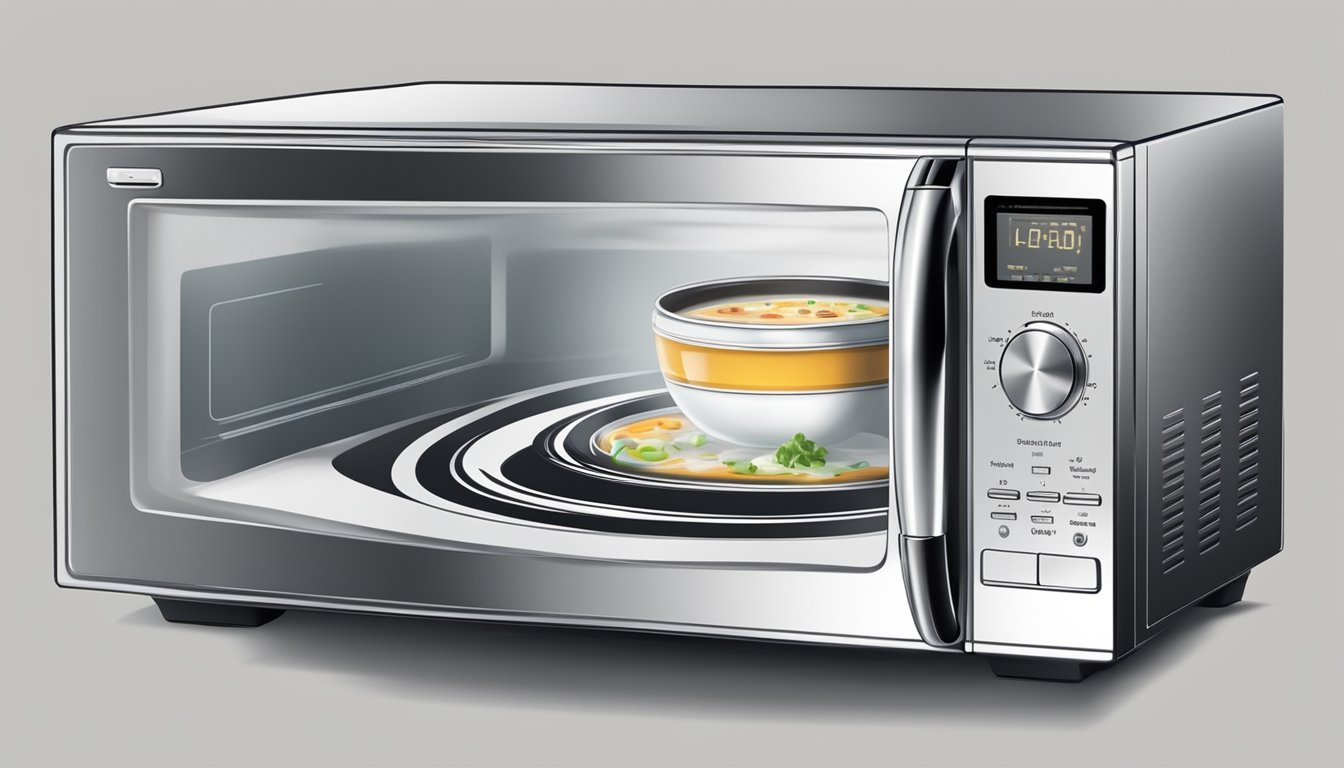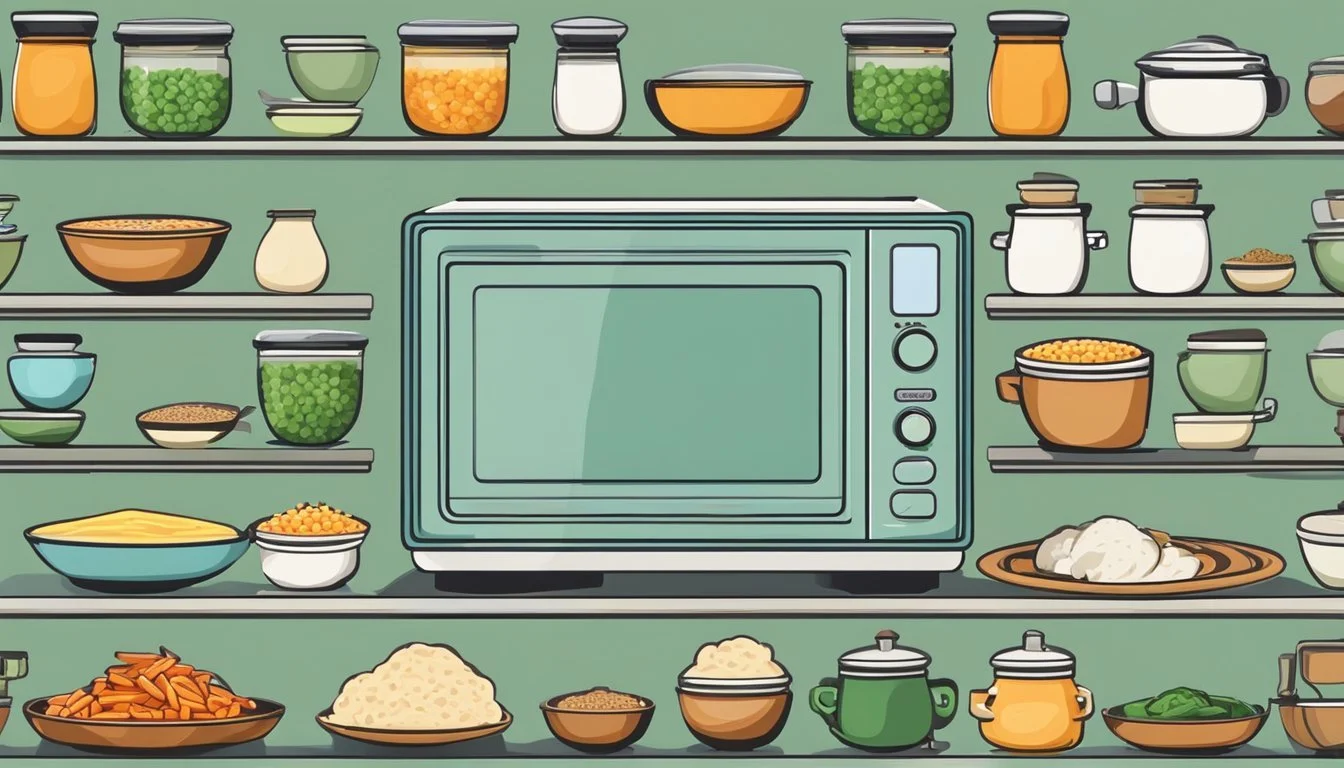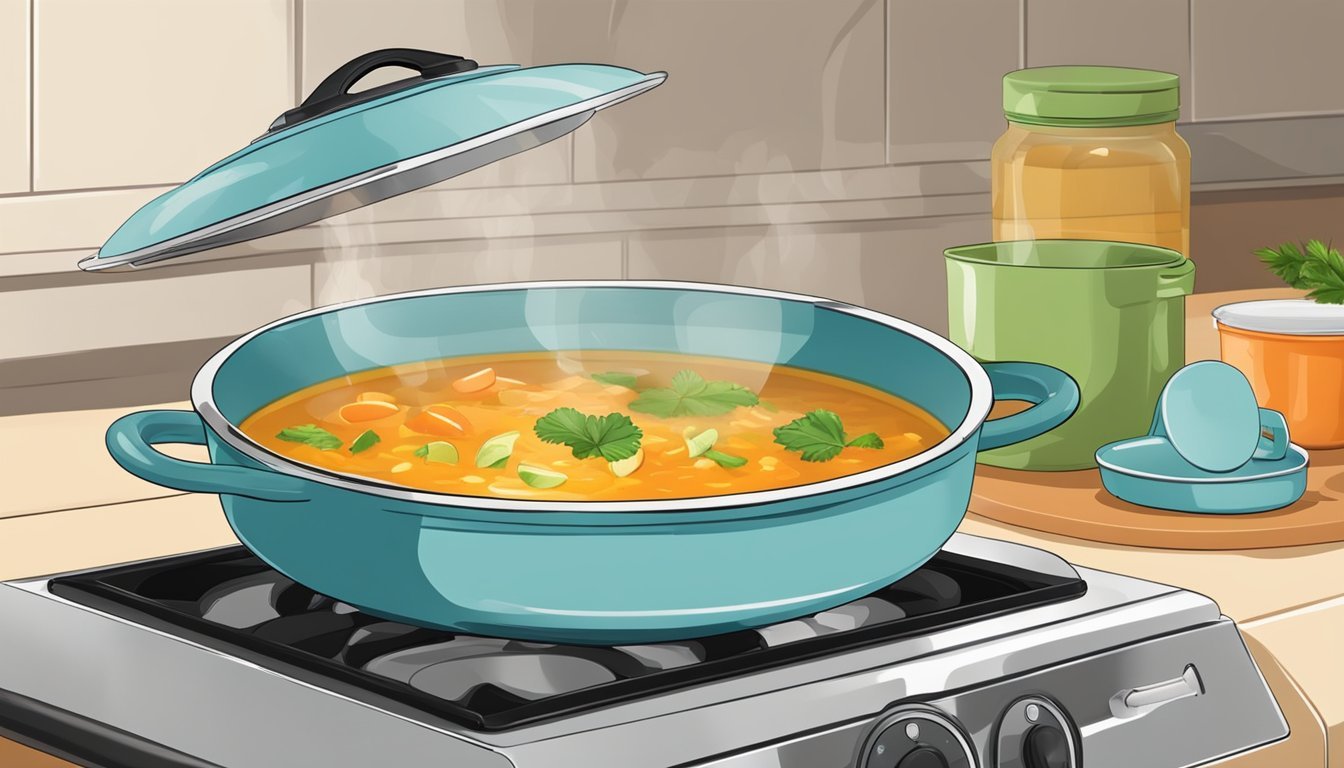Best Way to Reheat Soup Evenly Every Time
Expert Tips for Consistent Warmth
Reheating soup is a common kitchen task, yet many struggle to achieve an even temperature throughout. The key to perfectly warmed soup is understanding the appropriate heating methods and techniques that prevent overheating while ensuring that the entire dish reaches a palatable and safe temperature. With the right approach, one can enjoy the flavors of the soup as if it were freshly made.
Microwave reheating offers convenience and speed. The process involves placing the soup in a microwave-safe bowl, covering it with a lid or plate to contain moisture, and heating at medium power. Stirring the soup at intervals during the microwave process ensures an even distribution of heat, which is crucial for uniform warmth throughout the dish. It's also advisable to heat in short bursts to avoid overheating and to allow heat to disseminate after each interval.
Stovetop reheating, on the other hand, is preferred for gradual and controlled warming. A gentle simmer on a medium heat, with periodic stirring, can preserve the soup's texture and flavors. This method is particularly beneficial for soups (What wine goes well with soups?) containing ingredients that are sensitive to high heat or prone to separation. The stovetop technique also allows for easy adjustments to temperature, making it a reliable option for reheating soup evenly.
Understanding the Basics of Reheating Soup
Proper reheating techniques ensure that soup is warmed evenly and safe to consume. It involves considering the type of soup and maintaining temperatures that prevent bacterial growth.
Types of Soup and Their Reheating Needs
Different soups require varying methods to reheat properly. Cream-based soups benefit from a gentle heat to avoid separation and scorching. Broth-based soups are less delicate and can be heated more quickly. Seafood soups should be reheated carefully to avoid overcooking the delicate proteins.
Cream-based Soups: Reheat on low heat, stirring frequently.
Broth-based Soups: Can handle medium heat, with occasional stirring.
Seafood Soups: Reheat on the lowest setting and for the least amount of time to prevent rubbery seafood.
Safe Reheating Temperatures and Bacteria Control
Reheating soup safely is about reaching and maintaining an appropriate temperature to control bacteria. The USDA recommends a reheating temperature of at least 165°F (74°C) to ensure food safety. A food thermometer can confirm the soup is heated through to a safe temperature.
Appropriate Temperature: At least 165°F (74°C) for all types of soup.
Bacteria Control: Consistent application of heat helps eliminate potential bacteria.
When reheating, it’s imperative to stir the soup to ensure even heating and to check the temperature at different points, especially for thicker soups, to ensure uniform warmth throughout.
Preparation for Reheating Soup
Before reheating soup, it is essential to portion leftovers efficiently and understand storage and freezing best practices to maintain the soup's quality and texture.
Portioning Leftovers for Efficient Reheating
Portioning soup into smaller, meal-sized quantities before cooling can save time and simplify the reheating process. Transferring the soup into individual airtight containers helps preserve flavor and prevent freezer burn if frozen. It also allows for quicker thawing and prevents the need to reheat large quantities at once, which can lead to uneven warming.
Containers: Use shallow airtight containers for quicker cooling and efficient storage.
Portions: Divide the leftovers into single or family-sized servings based on future meals.
Storage and Freezing Best Practices
For optimal storage, soups should be refrigerated or frozen shortly after cooking. The cooling process should not be prolonged as it increases the risk of bacterial growth. Soups should be stored in the fridge if they are to be consumed within three days; otherwise, they should be frozen.
Refrigerate: Cool soups quickly and refrigerate in airtight containers. Consume within 3 days.
Freezer Safe Containers: For longer storage, use freezer-safe containers to protect the soup's texture and prevent freezer burn.
Freezing: Label containers with the date and contents. Soups can be frozen for up to 3 months.
Thawing: Thaw frozen soup in the fridge overnight. For faster defrosting, use the microwave or a water bath, ensuring even heat distribution while monitoring to prevent over-cooking.
Reheating Techniques and Methods
To ensure soup is reheated evenly and safely, two effective methods are commonly used: stovetop reheating and microwave reheating. Each method requires specific steps to maintain the soup's flavor and texture.
Stovetop Reheating for Even Heat Distribution
Stovetop reheating is ideal for achieving an even heat distribution. To reheat soup on the stovetop, one should:
Pour the desired amount of soup into a saucepan.
Place the saucepan over medium heat.
Stir the soup occasionally to promote uniform warming and prevent sticking or scorching.
Once the soup is heated thoroughly, which typically means reaching a temperature where it starts to steam but before boiling, reduce the heat.
Let it simmer for a few minutes to ensure the soup is heated through.
It’s advisable to cover the saucepan with a lid to retain moisture and flavors.
Microwave Reheating for Speed and Convenience
Microwave reheating offers a quick and convenient way to warm soup. Steps for microwave reheating include:
Transfer soup into a microwave-safe bowl.
To prevent splatters and maintain moisture, cover the bowl with a microwave-safe lid or a splatter guard.
Heat the soup on medium power for an initial period of 2 minutes.
After the initial heat, stir the soup to help disperse heat evenly throughout.
Continue heating in 30-second intervals, stirring between each one to maintain even heating.
Soup should be checked frequently to avoid overheating or uneven heating.
By following these methods, one can reheat soup effectively, preserving its flavor and ensuring it is warm and ready to serve.
Special Considerations for Different Soup Ingredients
To reheat soup evenly and maintain its quality, it's crucial to consider how different ingredients interact with heat. Soups often contain a mix of dairy, grains, pasta, vegetables, and proteins, each requiring a tailored approach to reheating.
Managing Dairy, Grains, and Pasta in Soups
Dairy Products: Dairy-based soups, like creamy chicken or vegetable soup, are prone to separation or curdling if overheated. They should be reheated gently over low heat, stirring frequently to prevent this issue.
Milk: Reheat soups containing milk gradually on the stove rather than in a microwave to better control the temperature and avoid scalding.
Grains and Pasta:
Rice, Quinoa, and Similar Grains: These can become mushy if overcooked. When reheating, one should aim to just warm them through, rather than cook further.
Pasta and Noodles: Overheating these can also lead to a mushy texture. Add pasta and noodles to the soup after the liquid has been reheated, warming them for a shorter period.
Retaining Texture of Vegetables and Proteins
Vegetables: One's goal should be to preserve the vegetables' firmness while reheating. Quick reheating methods like steaming or a brief stint in the microwave help to keep vegetables crisp in mixed soups.
Firm Vegetables: Root vegetables hold up well during reheating; however, they should still be monitored to maintain their texture.
Proteins:
Chicken: Reheat chicken soup slowly on the stove, stirring occasionally to ensure even warming and to prevent the chicken from drying out.
Tables summarizing the above information:
Ingredient Type Reheating Method Special Consideration Dairy Products Low heat on stove Stir frequently to prevent separation Grains Stove, minimal time Warm, don’t cook; aim for firm texture Pasta/Noodles Add late in reheating Brief warming to prevent mushiness Vegetables Steam or quick microwave Preserve firmness; don't overcook Proteins (e.g., Chicken) Stove, slow and steady Stir occasionally; prevent drying out
Finishing Touches and Maintaining Flavor
When reheating soup, the final steps are crucial for preserving and enhancing the flavors. Fine adjustments can elevate the soup's taste to ensure an enjoyable eating experience.
Adjusting Seasoning and Acidity After Reheating
Seasoning is essential for any soup, and reheating can often alter the balance.
Salt: Add a pinch if the soup tastes bland; salt heightens other flavors.
Acidity: A squeeze of lime juice can brighten the overall flavor profile.
A soup's flavor can diminish during storage; thus, re-tasters should always check and adjust seasoning post-reheat. Acidity, often overlooked, can invigorate a soup's taste, making spices and herbs more pronounced.
Incorporating Fresh Ingredients for Improved Taste
Fresh ingredients added after reheating enhance the depth and appeal of a soup.
Vegetables: Introduce freshly chopped herbs or vegetables for added texture and flavor bursts.
Cream or Butter: For creamy soups, a spoonful of cream or a pat of butter reintroduced after reheating can return the velvety texture.
Roux: If the soup base has thinned, a small amount of roux—equal parts cooked flour and butter—can thicken it effectively.
By stirring in fresh ingredients, chefs harness their full potential, achieving a vibrancy similar to when the soup was first made. Homemade soups, in particular, benefit from these final touches, which can reinforce the flavor of the underlying stock or broth. Enhancements should be applied conservatively, ensuring that they complement rather than dominate the existing flavors.
Troubleshooting Common Reheating Issues
When reheating soup, maintaining the texture and flavor of the original dish is paramount. Two common challenges are preventing the separation of ingredients in creamy soups and avoiding overcooking that can result in soggy additives.
Handling Separation in Creamy Soups
Creamy soups can separate and lose their silky texture when reheated improperly. To avoid this:
Start low and slow: Gradually warm the soup on a low heat setting, stirring frequently to maintain an even temperature.
Stabilize with starch: If separation occurs, a small amount of cornstarch or flour mixed with cold water can be added to the soup to help emulsify and stabilize it.
Preventing Overcooking and Soggy Ingredients
Overcooking can compromise not just the taste but also the texture of leftover soup. Key strategies to prevent this are:
Reheat in stages: Warm the soup in short bursts, stirring between each to allow the heat to distribute evenly, especially when using a microwave.
Add fresh ingredients: If the soup contains pasta or vegetables that may become too soft, consider removing them before reheating the soup and adding them back in just before serving.
Safety Tips and Preserving Soup Quality
Understanding the importance of safely reheating soup and maintaining its quality is essential for both taste and health. It's critical that individuals reheat soup to the right temperature and store it properly to preserve its flavor and nutritional value.
Reheating Safety Guidelines to Prevent Foodborne Illness
When reheating soup, one must consistently reach a safe internal temperature of 165°F (74°C) to prevent foodborne illness. A food thermometer should be used to verify the temperature. Soup should be stirred regularly to ensure even heating. Additionally, if the soup is stored in the refrigerator, it should not be left at room temperature for more than two hours to avoid bacterial growth. For cooling hot soup before storage, it is recommended to do so within 2 hours, placing it in a shallow container to allow it to cool quickly and evenly.
Key considerations for reheating:
Temperature: Heat soup to at least 165°F.
Stirring: Frequently stir for even heat distribution.
Cooling: Cool hot soup within 2 hours before refrigeration.
Best Practices for Maintaining Soup Quality
Proper storage is pivotal in maintaining soup quality. Soup should be stored in airtight containers made of either plastic or glass and labeled with the date of storage. Plastic is a common choice for its convenience, but glass can be preferable to avoid potential plastic contamination when heated. Freezing soup provides a longer shelf life, up to three months, and it is most effective when done in meal-sized portions to avoid unnecessary thawing and refreezing. Soups should be thawed in the refrigerator or using the microwave's defrost setting.
To protect the quality when reheating:
Storage Containers: Use airtight, ideally glass containers.
Labeling: Clearly label with the storage date.
Portion Size: Store in meal-sized portions for optimal thawing.
By following these guidelines, individuals ensure both the safety and quality of their soup.
Advanced Reheating Strategies
To reheat soup evenly and preserve its flavor, it is worth considering advanced reheating methods that go beyond the basics of microwave or stovetop warming. These strategies can be particularly beneficial for large batches of soup or when doing meal prep.
Using Alternate Appliances for Reheating
Crockpot: For those who prefer a gentle reheating process that doesn't risk scorching the soup, a crockpot is an efficient tool. It is ideal for stews and thicker soups, which benefit from the slow and even heating. To use a crockpot, simply transfer the soup into the appliance and set it to the low heat setting. Allow it to warm for an hour or two, checking periodically to ensure it has reached the desired temperature without overcooking.
General Guidelines for Crockpot Reheating:
Low heat setting: Slowly brings soup to temperature.
Timing: Typically 1-2 hours, depending on quantity.
Stirring: Occasional stirring promotes even heat distribution.
Techniques for Large Batches and Meal Prep
Batch Reheating: When reheating large quantities of leftovers or meal prep, one must be mindful to heat the soup consistently throughout. A stovetop method can be employed by placing the soup in a large pot and warming it over a medium flame. Stirring frequently is crucial to prevent sticking and to ensure that the heat penetrates the center of the batch.
Efficient Stovetop Method:
Medium Flame: Offers a balance between gentle and quick reheating.
Stirring: Crucial for even heat distribution, especially in dense stews.
For those who have prepared individual portions in advance, reheating can be done by placing the specific amount needed in a microwave-safe bowl, covering with a lid or microwave-safe covering, and heating at medium power. Stirring between short intervals of 30 seconds to a minute will guarantee homogenous temperatures across the portion.
Microwave Method for Prepped Portions:
Power Setting: Medium power to avoid overheating delicate ingredients.
Intervals: Heat in increments of 30 seconds to 1 minute, stirring in between.
Frequently Asked Questions
Can I reheat soup in the microwave?
Yes, one can safely reheat soup in the microwave. It's best to transfer the soup to a microwave-safe bowl, cover it, and heat on medium power. Stirring the soup at regular intervals ensures even heating.
What is the best way to reheat thickened soups?
For thickened soups, gentle heat on the stove is advisable. One should stir occasionally to prevent the soup from sticking to the pot and maintain an even temperature throughout.
How long can chicken noodle soup be stored as leftovers?
Leftover chicken noodle soup can be stored in the refrigerator for three to five days. Always taste before reheating to ensure quality.
Are there tips for reheating soup components like noodles or vegetables?
For soups with delicate components, reheating on the stove with occasional stirring is recommended. This method helps to prevent overcooking of vegetables or noodles.
Should I use the defrost setting to reheat soup?
The defrost setting is generally for thawing frozen food. For reheating soup, using medium power is more suitable to warm it evenly without overheating.
Does reheating soup affect its calories?
Reheating soup does not significantly alter its calorie content. However, one should be mindful of any added ingredients during the reheating process.
When reheating leftover soup, it's crucial to reach a safe temperature throughout, which is 165°F (74°C). Always cover the soup to retain moisture and heat evenly.




